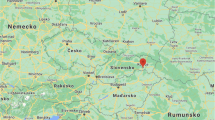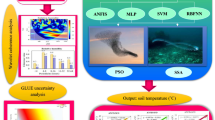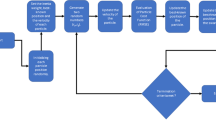Abstract
This study compares single and hybrid soft computing models for estimating daily solar radiation flux for two scenarios. Scenario I developed single soft computing models, including multilayer perceptron (MLP), support vector machines (SVM), adaptive neuro-fuzzy inference system (ANFIS), and multivariate adaptive regression splines (MARS), for estimating daily solar radiation flux at two stations from the USA and South Korea. The MLP model was used to evaluate the effect of factors controlling daily solar radiation flux. Using different combinations of controlling factors as input, the MLP and SVM models, based on evaluation measures, were found to be superior to the ANFIS and MARS models at Big Bend station, USA. In addition, the MLP, SVM, and MARS models performed better than did the ANFIS model at Incheon station, South Korea. Scenario II combined the discrete wavelet transform (DWT) and single soft computing models (e.g., MLP and SVM) for improved performance using 4-input combination. The wavelet-based MLP (WMLP) and SVM (WSVM) models were superior to other single soft computing models (MLP, SVM, ANFIS, and MARS) at two stations. Taylor diagrams, violin plots and point density plots were also utilized to examine the similarity between the observed and estimated solar radiation flux values. Results showed that scenarios I and II can be alternatives for estimating daily solar radiation flux based on different meteorological information, such as peninsular and continental conditions.













Similar content being viewed by others
Explore related subjects
Discover the latest articles and news from researchers in related subjects, suggested using machine learning.References
Adamowski J, Chan HF (2011) A wavelet neural network conjunction model for groundwater level forecasting. J Hydrol 407(1–4):28–40
Adamowski J, Sun K (2010) Development of a coupled wavelet transform and neural network method for flow forecasting of non-perennial rivers in semi-arid watersheds. J Hydrol 390(1–2):85–91
Akrami SA, Nourani V, Hakim SJS (2014) Development of nonlinear model based on wavelet-ANFIS for rainfall forecasting at Klang Gates Dam. Water Resour Manag 28(10):2999–3018
ASCE Task Committee (1993) Criteria for evaluation of watershed models. J Irrig Drain Eng ASCE 119(3):429–442
Baba APA, Shiri J, Kisi O, Fard AF, Kim S, Amini R (2013) Estimating daily reference evapotranspiration using available and estimated climatic data by adaptive neuro-fuzzy inference system (ANFIS) and artificial neural network (ANN). Hydrol Res 44(1):131–146
Cao S, Cao J (2005) Forecast of solar irradiance using recurrent neural networks combined with wavelet analysis. Appl Therm Eng 25(2):161–172
Cao JC, Cao SH (2006) Study of forecasting solar irradiance using neural networks with preprocessing sample data by wavelet analysis. Energy 31(15):3435–3445
Cao J, Lin X (2008) Study of hourly and daily solar irradiation forecast using diagonal recurrent wavelet neural networks. Energy Convers Manag 49(6):1396–1406
Capizzi G, Napoli C, Bonanno F (2012) Innovative second-generation wavelets construction with recurrent neural networks for solar radiation forecasting. IEEE Trans Neural Netw Learn Syst 23(11):1805–1815
Chen JL, Liu HB, Wu W, Xie DT (2011) Estimation of monthly solar radiation from measured temperatures using support vector machines–a case study. Renew Energy 36(1):413–420
Chen JL, Li GS, Wu SJ (2013) Assessing the potential of support vector machine for estimating daily solar radiation using sunshine duration. Energy Convers Manag 75:311–318
Cheng MY, Cao MT (2014) Accurately predicting building energy performance using evolutionary multivariate adaptive regression splines. Appl Soft Comput 22:178–188
Coulibaly P, Anctil F, Aravena R, Bobée B (2001) Artificial neural network modeling of water table depth fluctuations. Water Resour Res 37(4):885–896
Deo RC, Şahin M (2017) Forecasting long-term global solar radiation with an ANN algorithm coupled with satellite-derived (MODIS) land surface temperature (LST) for regional locations in Queensland. Renew Sust Energ Rev 72:828–848
Dorvlo AS, Jervase JA, Al-Lawati A (2002) Solar radiation estimation using artificial neural networks. Appl Energy 71(4):307–319
Evrendilek F (2014) Assessing neural networks with wavelet denoising and regression models in predicting diel dynamics of eddy covariance-measured latent and sensible heat fluxes and evapotranspiration. Neural Comput & Applic 24(2):327–337
Friedman JH (1991) Multivariate adaptive regression splines. Ann Stat 19:1–67
Ghimire S, Deo RC, Downs NJ, Raj N (2018) Self-adaptive differential evolutionary extreme learning machines for long-term solar radiation prediction with remotely-sensed MODIS satellite and reanalysis atmospheric products in solar-rich cities. Remote Sens Environ 212:176–198
González-Audícana M, Otazu X, Fors O, Seco A (2005) Comparison between Mallat’s and the ‘à trous’ discrete wavelet transform based algorithms for the fusion of multispectral and panchromatic images. Int J Remote Sens 26(3):595–614
Hajian M (2013) Various aspects of solar energy utilization: review. Int J Adv Sci Technol 58:41–50
Haykin S (2009) Neural networks and learning machines, 3rd ed. Prentice Hall, NJ
Heo KY, Ha KJ, Yun KS, Lee SS, Kim HJ, Wang B (2014) Methods for uncertainty assessment of climate models and model predictions over East Asia. Int J Climatol 34(2):377–390
Jain SK, Nayak PC, Sudheer KP (2008) Models for estimating evapotranspiration using artificial neural networks, and their physical interpretation. Hydrol Process 22:2225–2234
Jang JSR (1993) ANFIS: adaptive-network-based fuzzy inference system. IEEE Trans Syst Man Cybern Syst 23(3):665–685
Jang JSR, Sun CT, Mizutani E (1997) Neuro-fuzzy and soft computing: a computational approach to learning and machine intelligence. Prentice-Hall, New Jersey
Kim S, Singh VP (2014) Modeling daily soil temperature using data-driven models and spatial distribution. Theor Appl Climatol 118(3):465–479
Kim S, Singh VP (2015) Spatial disaggregation of areal rainfall using two different artificial neural networks. Water 7(6):2707–2727
Kim S, Shiri J, Kisi O (2012) Pan evaporation modeling using neural computing approach for different climatic zones. Water Resour Manag 26(11):3231–3249
Kim S, Shiri J, Kisi O, Singh VP (2013) Estimating daily pan evaporation using different data-driven methods and lag-time patterns. Water Resour Manag 27(7):2267–2286
Kim S, Seo Y, Singh VP (2015a) Assessment of pan evaporation modeling using bootstrap resampling and soft computing methods. J Comput Civ Eng 29:04014063. https://doi.org/10.1061/(ASCE)CP.1943-5487.0000367
Kim S, Singh VP, Lee CJ, Seo Y (2015b) Modeling the physical dynamics of daily dew point temperature using soft computing techniques. KSCE J Civ Eng 19(6):1930–1940
Kim S, Seo Y, Singh VP (2016a) Computation of daily solar radiation using wavelet and support vector machines: a case study. In: Harmony Search Algorithm, Springer Berlin Heidelberg, pp 279–284
Kim S, Seo Y, Singh VP (2016b) Estimating global solar irradiance for optimal photovoltaic system. Procedia Eng 154:1237–1242
Kisi O (2014) Modeling solar radiation of Mediterranean region in Turkey by using fuzzy genetic approach. Energy 64:429–436
Kisi O, Cimen M (2011) A wavelet-support vector machine conjunction model for monthly streamflow forecasting. J Hydrol 399(1–2):132–140
Kisi O, Cimen M (2012) Precipitation forecasting by using wavelet-support vector machine conjunction model. Eng Appl Artif Intell 25(4):783–792
Kisi O, Kim S, Shiri J (2013) Estimation of dew point temperature using neuro-fuzzy and neural network techniques. Theor Appl Climatol 114(3–4):365–373
Legates DR, Davis RE (1997) The continuing search for an anthropogenic climate change signal: limitations of correlation-based approaches. Geophys Res Lett 24(18):2319–2322
Legates DR, McCabe GJ (1999) Evaluating the use of “goodness-of-fit” measures in hydrologic and hydroclimatic model validation. Water Resour Res 35(1):233–241
Legates DR, McCabe GJ (2013) A refined index of model performance: a rejoinder. Int J Climatol 33(4):1053–1056
Mallat SG (1989) A theory for multiresolution signal decomposition: the wavelet representation. IEEE Trans Pattern Anal Mach Intell 11(7):674–693
Mellit A, Benghanem M, Kalogirou SA (2006) An adaptive wavelet-network model for forecasting daily total solar-radiation. Appl Energy 83(7):705–722
Moghaddamnia A, Remesan R, Kashani MH, Mohammadi M, Han D, Piri J (2009) Comparison of LLR, MLP, Elman, NNARX and ANFIS models—with a case study in solar radiation estimation. J Atmos Sol Terr Phys 71(8):975–982
Mohammadi K, Shamshirband S, Anisi MH, Alam KA, Petković D (2015a) Support vector regression based prediction of global solar radiation on a horizontal surface. Energy Convers Manag 91:433–441
Mohammadi K, Shamshirband S, Tong CW, Arif M, Petković D, Ch S (2015b) A new hybrid support vector machine–wavelet transform approach for estimation of horizontal global solar radiation. Energy Convers Manag 92:162–171
Moosavi V, Vafakhah M, Shirmohammadi B, Behnia N (2013) A wavelet-ANFIS hybrid model for groundwater level forecasting for different prediction periods. Water Resour Manag 27(5):1301–1321
Nash JE, Sutcliffe JV (1970) River flow forecasting through conceptual models, part 1—a discussion of principles. J Hydrol 10(3):282–290
Nason G (2010) Wavelet methods in statistics with R. Springer, NY
Nourani V, Alami MT, Aminfar MH (2009) A combined neural-wavelet model for prediction of Ligvanchai watershed precipitation. Eng Appl Artif Intell 22(3):466–472
Piri J, Kisi O (2015) Modelling solar radiation reached to the Earth using ANFIS, NN-ARX, and empirical models (case studies: Zahedan and Bojnurd stations). J Atmos Sol Terr Phys 123:39–47
Principe JC, Euliano NR, Lefebvre WC (2000) Neural and adaptive systems: fundamentals through simulation. Wiley, NY, USA
Salcedo-Sanz S, Deo RC, Cornejo-Bueno L, Camacho-Gómez C, Ghimire S (2018) An efficient neuro-evolutionary hybrid modelling mechanism for the estimation of daily global solar radiation in the Sunshine State of Australia. Appl Energy 209:79–94
Santos, C.A.G., Freire, P.K.M.M., Silva, G.B.L., Silva, R.M. (2014). Discrete wavelet transform coupled with ANN for daily discharge forecasting into Três Marias reservoir. In: Proceedings of the International Association of Hydrological Sciences, Bologna, Italy, pp 100–105
Sehgal V, Sahay RR, Chatterjee C (2014) Effect of utilization of discrete wavelet components on flood forecasting performance of wavelet based ANFIS models. Water Resour Manag 28(6):1733–1749
Seo Y, Kim S, Kisi O, Singh VJ (2015) Daily water level forecasting using wavelet decomposition and artificial intelligence techniques. J Hydrol 520:224–243
Sharda VN, Prasher SO, Patel RM, Ojasvi PR, Prakash C (2008) Performance of multivariate adaptive regression splines (MARS) in predicting runoff in mid-Himalayan micro-watersheds with limited data/performances. Hydrol Sci J 53(6):1165–1175
Shirmohammadi B, Moradi H, Moosavi V, Semiromi MT, Zeinali A (2013) Forecasting of meteorological drought using wavelet-ANFIS hybrid model for different time steps (case study: southeastern part of East Azerbaijan Province, Iran). Nat Hazards 69(1):389–402
Sigaroodi SK, Chen Q, Ebrahimi S, Nazari A, Choobin B (2014) Long-term precipitation forecast for drought relief using atmospheric circulation factors: a study on the Maharloo Basin in Iran. Hydrol Earth Syst Sci 18:1995–2006
Sözen A, Arcaklioğlu E, Özalp M (2004) Estimation of solar potential in Turkey by artificial neural networks using meteorological and geographical data. Energy Convers Manag 45(18):3033–3052
Sumithira TR, Kumar AN (2012) Prediction of monthly global solar radiation using adaptive neuro fuzzy inference system (ANFIS) technique over the state of Tamilnadu (India): a comparative study. Appl Solar Energy 48(2):140–145
Taylor KE (2001) Summarizing multiple aspects of model performance in a single diagram. J Geophys Res Atmos 106(D7):7183–7192
Tiwari MK, Chatterjee C (2010) Development of an accurate and reliable hourly flood forecasting model using wavelet-bootstrap-ANN (WBANN) hybrid approach. J Hydrol 394(3–4):458–470
Tripathi S, Srinivas VV, Nanjundish RS (2006) Downscaling of precipitation for climate change scenarios: a support vector machine approach. J Hydrol 330(3–4):621–640
Tsoukalas LH, Uhrig RE (1997) Fuzzy and neural approaches in engineering. Wiley, NY
Vakili M, Sabbagh-Yazdi SR, Kalhor K, Khosrojerdi S (2015) Using artificial neural networks for prediction of global solar radiation in Tehran considering particulate matter air pollution. Energy Procedia 74:1205–1212
Vapnik VN (2010) The nature of statistical learning theory, 2nd edition. Springer, NY
Wang J, Xie Y, Zhu C (2011a) Solar radiation prediction based on phase space reconstruction of wavelet neural network. Procedia Eng 15:4603–4607
Wang J, Xie Y, Zhu C, Xu X (2011b) Daily solar radiation prediction based on genetic algorithm optimization of wavelet neural network. In IEEE Electrical and Control Engineering (ICECE), 2011 International Conference on, pp 602–605
Willmott CJ, Robeson SM, Matsuura K (2012) A refined index of model performance. Int J Climatol 32(13):2088–2094
Zhang WG, Goh ATC (2013) Multivariate adaptive regression splines for analysis of geotechnical engineering systems. Comput Geotech 48:82–95
Acknowledgments
The authors would like to reveal our extreme appreciation and gratitude to the Illinois State Water Survey (ISWS), USA, and Korea Meteorological Administration (KMA), South Korea. This is for providing the meteorological information. In addition, the authors also sincerely thank the editors and reviewers for their admirable revision and scientific suggestions.
Author information
Authors and Affiliations
Corresponding author
Rights and permissions
About this article
Cite this article
Kim, S., Seo, Y., Rezaie-Balf, M. et al. Evaluation of daily solar radiation flux using soft computing approaches based on different meteorological information: peninsula vs continent. Theor Appl Climatol 137, 693–712 (2019). https://doi.org/10.1007/s00704-018-2627-x
Received:
Accepted:
Published:
Issue Date:
DOI: https://doi.org/10.1007/s00704-018-2627-x




